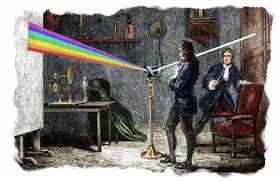For nearly two
thousand years, scientists believed that all colors are formed by a mixture of
light and darkness. In blue, for example, there is a lot of darkness, and it is
slightly diluted with light, in yellow, on the contrary, there is a lot of
light, and there is little darkness. According to this theory, it turned out
that the main colors are white and black; the rest are combinations thereof.
Everyone believed in it. But no one was able to verify this - to decompose some
color into white and black, into darkness and light.
The first person
who checked - and at the same time refuted - this theory, was the great
mathematician and physicist Isaac Newton.
 |
| Newton's discovery |
In 1666, when he
was twenty-four years old, Newton began to study sunlight. He closed the window
in the room with a dense shutter and drilled a small hole in it, through which
a very narrow beam of light penetrated. Not far from the window, Newton set the
glass prism with its edge down, it was just in the path of the sun's beam.
Before the beam reached the wall, it had to pass through the prism. Why did
Newton set a prism?
A prism refracts
the rays of light, forcing them to change their original path. But it turns out
that the prism has also another property: it refracts the rays of different
colors in different ways. If a beam consisting of a mixture of rays of
different colors — violet, red, green — enters the prism, then the rays will no
longer go out of the prism together, but each their own way: the glass will
sort all these rays that were previously mixed together.
 |
| Rainbow |
For this, Newton
closed the shutter of his room, leaving only a small hole in it: he decided to
filter through the prism the white sunlight, the same light that everyone
considered basic and not decomposable into any other colors. And here is what
he saw: a sheaf of multicolored rays emerged from the prism, and instead of a
round white sunbeam, a rainbow strip appeared on the wall - a spectrum. So
Newton made a big discovery: he proved that the accepted explanation of colors
is not true.
The white color,
which was considered the main one, actually turned out to be a mixture of as
many as seven colors.